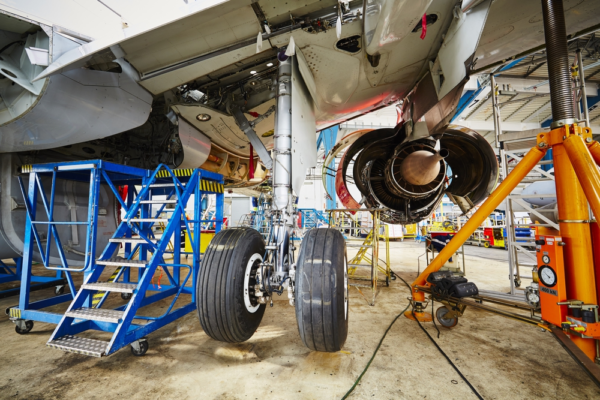
The Internet of Things, or IoT, is a new technology that has immense potential for the manufacturing industry. The more complex the sector, the more it can benefit from IoT. The aerospace industry, therefore, stands to benefit greatly from implementing IoT devices into its processes. IoT’s capacity to facilitate a seamless digital transformation in aerospace manufacturing is not just revolutionary; it’s essential. But what makes IoT indispensable for aerospace manufacturing and testing?Let’s examine the aims of IoT and how it forms part of a cohesive digital transformation in aerospace.
The Impact of IoT on Aerospace Manufacturing
The Internet of Things Equals Endless Data
At its core, the goal of IoT is to gather data. Each IoT device can serve as a data point that can inform your systems. The more IoT devices you connect, the more data you can collect. IoT devices tend to be very simple, which allows them to have specialized applications and be installed easily wherever needed. For example, in lieu of a standard analog temperature sensor, you could use an IoT temperature sensor that reports data to a hub.
The difference may seem minor, but it is actually extremely significant. Analog sensors work as part of a closed system; a machine’s temperature sensor reports overheating and can stop operation. In contrast, an IoT sensor can perform that same function while also logging data at high frequencies. That data is then transferred to other systems, enabling an open-ended network that can automate tasks and derive insights from data. Consider some use cases to understand the potential impact of IoT.
Revolutionizing Aerospace with Virtual Design and Testing
Virtual testing has enormous implications for manufacturing, especially in aerospace where testing requirements are higher than in any other industry. However, one of the challenges of virtual testing is its reliability in comparison to real-world tests. A simulated virtual environment makes assumptions that may not be true in real-world situations. IoT devices can solve this problem by taking real-world data and using it to build the virtual environment for further testing.
This “virtual manufacturing” approach can greatly reduce R&D times, optimize manufacturing processes, and produce more reliable parts and components. As part of a wider industry 4.0 model, IoT and virtual manufacturing serve as the foundation for further automation and data analysis. All of this sounds excellent in theory, but how do you translate virtual manufacturing into actual products that you can sell?
Improving Aerospace Manufacturing Processes With IoT
By planning your production virtually, you will have more accurate estimates to guide your manufacturing. You can place more accurate purchase orders for raw materials to minimize waste. With a clearer picture of how long your production will take, you can set realistic deadlines and allocate human resources appropriately. By collecting data from finished components, you can measure real-world performance and compare it to your virtual expectations to make your virtual models more accurate and continue optimizing your fabrication.
How does IoT make this work? IoT devices strewn throughout your manufacturing line can monitor and report on your progress. For example, laser-etched QR codes could be applied to parts, and then scanned by simple IoT cameras as the part progresses through your industrial process. Image processing can even evaluate the shape of a component to quickly see if it’s within spec or if it should be discarded. Tracking parts this way also helps you keep an accurate inventory.
Predictive Maintenance Powered by IoT
IoT can also help you keep your machines up and running with predictive maintenance. Installing IoT sensors on your machines can yield data that reveals the machine’s condition. For example, a vibration sensor on a precise CNC mill will output data at millisecond frequencies. If that data yields a value outside of operating specifications or begins to show a trend in that direction, your system could automatically inform engineering that the machine needs service.
The predictive approach is much more efficient than simply following the schedule in the machine’s manual. Over time, you will learn more about each of your machines. You can then make schedules that more accurately reflect the likelihood of failure and program maintenance during slower periods rather than being surprised by downtime. This is one of the best ways to optimize your aerospace manufacturing and reduce expenses.
IoT and Automation
Automation has consistently yielded the biggest profit gains in manufacturing. It should come as no surprise then that IoT’s greatest potential lies in automation. IoT devices stand out because not only do they provide a consistent output of data, but they can also be configured to receive and relay inputs. These inputs could control operations on other machines to automate production and streamline your processes. With modern processing methods, data can be used in real time to control your machines.
Consider how this might work for a heavy-duty stamping machine. A sensor could determine if each stamping was done correctly, perhaps a camera near the output or a pressure sensor to measure the added weight in a bin after a part is made. If the sensor outputs acceptable data, your system sends an input back to repeat the process. If not, it could automatically halt the machine if a jam or fault is detected to minimize damage or further waste.
Analyze Data With a Digital Transformation in Aerospace
Data on its own won’t suddenly turn your operation into an Industry 4.0 powerhouse. To turn data into action, you need to undergo a digital transformation in aerospace. A digital transformation will include cloud-based systems that can collect, analyze, and utilize your data. This transformation can go beyond your manufacturing processes and include other business activities too.
At SAAB RDS, we have expertise in IoT solutions to enhance you Aerospace business.
Contact us to learn more about how we can help your aerospace manufacturing company transition to a digital future powered by IoT.
